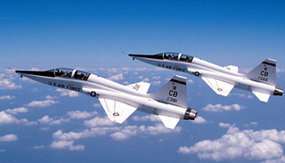T-38 Talon
|
|
| T-38 Talon | ||
|---|---|---|
| Description | ||
| Role | Advanced trainer | |
| Crew | 2: student and instructor | |
| Dimensions | ||
| Length | 46 ft 4 1/2 in | 14.1 m |
| Wingspan | 25 ft 3 in | 7.7 m |
| Height | 12 ft 10.5 in | 3.92 m |
| Wing area | 170 ft² | 15.79 m² |
| Weights | ||
| Empty | 7,200 lb | 3,266 kg |
| Loaded | 11,820 lb | 5,361 kg |
| Maximum take-off | ||
| Powerplant | ||
| Engines | Two General Electric J85-5A afterburning turbojets | |
| Thrust | 3,850 lbf | 17 kN |
| Performance | ||
| Maximum speed | 858 mph (Mach 1.3) | 1,381 km/h |
| Combat range | 1,140 mi | 1,835 km |
| Ferry range | ||
| Service ceiling | ||
| Rate of climb | 33,600 ft/min | 10,240 m/min |
The Northrop T-38 Talon is a US-built supersonic jet trainer for military pilots. It was the world’s first supersonic trainer and remains in service as of 2004.
History
The T-38 was designed in the mid 1950s as the trainer variant of a lightweight fighter project (the N-156 project) by the Northrop Corporation (today part of Northrop Grumman). Although the United States Air Force had no need for a small fighter at the time, it became interested in the trainer as a replacement for the Lockheed T-33s it was then using in this role. The first of three prototypes (designated YT-38) flew on March 10 1959. The type was quickly adopted and the first production examples were delivered in 1961, officially entering service on March 17 that year. When production ended in 1972, 1,187 T-38s had been built. Since its introduction, it is estimated that some 50,000 military pilots have trained on this aircraft.
The T-38 is of conventional configuration, with a small, low, long-chord wing, a single tail fin, and tricycle undercarriage. The aircraft seats a student pilot and instructor in tandem, and has intakes for its two turbojet engines at the wing roots. Its nimble performance has earned it the nickname white rocket - in 1962, T-38s set four climb records.
Most T-38s built were of the T-38A variant, but the USAF also had a small number of aircraft that had been converted for weapons training. These aircraft (designated AT-38B) had been fitted with a gunsight and could carry a gunpod, rockets, or bombs on a centreline pylon. In 2003, 562 T-38s were still operational with the USAF and are currently undergoing structural and avionics programmes (T-38C) to extend their service life to 2020. Improvements include the addition of a HUD,GPS,INS (Inertial Navigation System), and TCAS as well as a propulsion modification. All USAF variants (T-38A and AT-38B) are being converted to the T-38C standard.
Besides the USAF, other T-38 operators include the German Luftwaffe, the Portuguese Air Force,the Taiwanese Air Force, and the Turkish Air Force. It is also flown by NASA and Boeing, who use the type as a chase plane. There are also a very small number of them in private civilian hands.
The fighter version of the N-156 was eventually selected for the US’s Military Assistance Program (MAP) and produced as the F-5 Freedom Fighter. Many of these have since reverted to a weapons training role as various air forces have introduced newer types into service.
Citing fuel and maintenance costs, the Thunderbirds aerobatic display team of the U.S. Air Force used the T-38 Talon from 1974 until 1983 when it was replaced by the F-16 Fighting Falcon.
Missing image
ThunderbirdsT38.jpg
U.S. Air Force Thunderbirds
U.S. Air Force Thunderbirds flying T-38 Talons in formation
Related aircraft
| Modern USAF Series | Miscellaneous | |
| Attack--OA/A-10,AC-130H/U | RC-135V/W | |
| Bomber--B-52,-2,-1B,F-117A | OC-135B | |
| Fighter--F-15/E ,F-16 | KC-10,-135 | |
| T-1 Jayhawk | Electronic--E-3,-4B,-8C EC-130E/J,H | HC-130P/N |
| T-37 Tweet | Transport--C-5,-17,-141B, -20,-21 | MC-130E/H/P |
| T-38 Talon | C-22B, -32, -130, -37A, -40B/C | MH-53J/M |
| T-43 | Trainers--T-1, -37, -38, -43, -6 | HH-60G |
| T-6 Texan II | Weather--WC-130, -135 | UH-1N |
| UAV--RQ-1/MQ-1 UAV, Global Hawk | U-2S/TU-2S | |
| VC-25 |
|
Lists of Aircraft | Aircraft manufacturers | Aircraft engines | Aircraft engine manufacturers Airports | Airlines | Air forces | Aircraft weapons | Missiles | Timeline of aviation |

